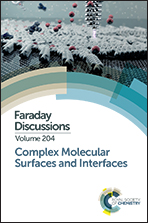What can be inferred from moiré patterns? A case study of trimesic acid monolayers on graphite†
Abstract
Self-assembly of benzene-1,3,5-tricarboxylic acid (trimesic acid – TMA) monolayers at the alkanoic acid–graphite interface is revisited. Even though this archetypal model system for hydrogen bonded porous networks is particularly well studied, the analysis of routinely observed superperiodic contrast modulations known as moiré patterns lags significantly behind. Fundamental questions remain unanswered such as, are moiré periodicity and orientation always the same, i.e. is exclusively only one specific moiré pattern observed? What are the geometric relationships (superstructure matrices) between moiré, TMA, and graphite lattices? What affects the moiré pattern formation? Is there any influence from solvent, concentration, or thermal treatment? These basic questions are addressed via scanning tunneling microscopy experiments at the liquid–solid interface, revealing a variety of different moiré patterns. Interestingly, TMA and graphite lattices were always found to be ∼5° rotated with respect to each other. Consequently, the observed variation in the moiré patterns is attributed to minute deviations (<2°) from this preferred orientation. Quantitative analysis of moiré periods and orientations facilitates the determination of the TMA lattice parameter with picometer precision.
- This article is part of the themed collection: Complex Molecular Surfaces and Interfaces


 Please wait while we load your content...
Please wait while we load your content...